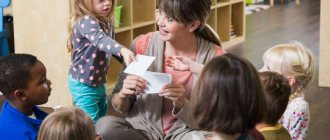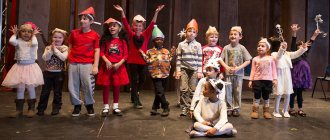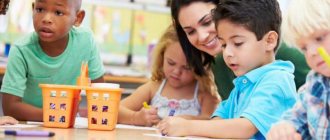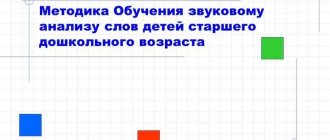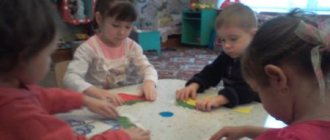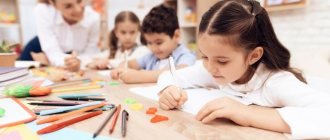Analysis of classes in preschool educational institutions according to the Federal State Educational Standard before. Sample self-analysis of a lesson in a preschool educational institution according to the Federal State Educational Standard before
Kristina Vershinina
Analysis of classes in preschool educational institutions according to the Federal State Educational Standard before. Sample self-analysis of a lesson in a preschool educational institution according to the Federal State Educational Standard before
Analysis of classes in preschool educational institutions according to Federal State Educational Standards for preschool education
General information
1. Topic of the lesson .
2. Date and place of its holding. Who conducts it?
3. Group.
4.Purpose:
• to solve what problems and develop what personality traits of students this lesson ;
•Tasks:
• how the specificity and realism of the goal is realized (from the point of view of sufficient time to complete it, compliance with the children’s preparedness for solving it in previous lessons , the capabilities and abilities of the children);
• how the integration of educational areas is implemented in accordance with the age capabilities and characteristics of students in the classroom .
5. Psychological justification for choosing the form and content of the activity:
• compliance of the lesson with general educational and correctional-developmental goals and objectives, the level of development of students, and their age characteristics;
• implementation of a comprehensive thematic principle (the topic of a particular lesson is chosen in the context of the general topic being studied);
• during the lesson, the joint activity of an adult and children is realized, the main component is interaction.
6. Observing the progress of the lesson
How convincingly, clearly, emotionally were the goals and objectives of the upcoming activity revealed to the students?
How meaningful, interesting and organized was the work?
What knowledge did the students acquire during the lesson :
what social attitudes were formed among the pupils, towards what socially useful
activities prompted their occupation ;
what vital values were formed.
Controllability of the lesson :
• how the opportunity to evaluate intermediate and final results is implemented;
• what conclusions did the students make during the course and at the end of the work;
• what results have been achieved.
How did the lesson the formation of public opinion of the group and individual students on their relationships.
what could be the consequence of this activity for the development of the team, for the formation of its social orientation.
What is its impact on individual pupils:
• emotional and aesthetic responsiveness to beauty in art;
work ethics, artistic activity.
aesthetics of behavior
Methods of work, the nature of relationships, their compliance with educational tasks, age and individual characteristics, the level of development of relationships in the group team.
7. General assessment of the educational event
• To what extent were educational goals and objectives achieved?
• Reasons for successes, failures, mistakes?
• General assessment of the educational value of the work performed.
•Psychological and pedagogical conclusions and suggestions to teachers and students:
• the effectiveness of the lesson in relation to each child;
• analysis of children’s activities (by the teacher)
and
children's self-analysis of their work ;
• reflective moment (the teacher encourages the child to express his attitude to the situation, to his activity).
8. Analysis of the teacher’s activities
Which character traits of the teacher contributed to effective work with students, which, on the contrary, hindered
• the teacher encourages children to show initiative and independence , encourages the manifestation of subjectivity;
• the teacher stimulates and encourages individual achievements of children;
What pedagogical abilities were demonstrated when carrying out effective work with students?
• the teacher takes into account the characteristics of each child (pace of activity, emotional state, level of development of mental processes, temperament)
• the teacher “sees”
each child: helps, stimulates, encourages.
Sample self-analysis of a lesson in a preschool educational institution according to the Federal State Educational Standard for Preschool Education
Goal: To develop children's interest in knowledge about vegetables through the integration of educational areas : cognition, communication, socialization, artistic creativity, health.
Tasks:
— Formation of children’s ideas about vegetables, the place of germination and their preparation for the winter;
-To strengthen children’s ability to describe vegetables according to their characteristic features, according to the diagram;
- Improving the ability to construct your statements grammatically correctly and consistently;
-Expand the active vocabulary, activate the names of vegetables in children’s speech.
-Continue to develop in children the ability to distinguish and name colors, to practice comparing objects by color;
-Encourage children to answer questions by pronouncing words clearly.
-Developing children’s ability to coordinate movements with text, understand and follow verbal instructions;
-Development of visual perception and memory, motor imagination and coordination of movements;
-Development of fine general and fine motor skills of the hands;
-Developing a friendly attitude towards peers;
-Creating a favorable emotional atmosphere and conditions for active play activities of children.
Organizational activities, preparation for class
The lesson was carried out in accordance with the notes. The abstract was compiled independently , in accordance with the objectives of the educational program corresponding to the given age of the children. To implement each task, techniques were selected in an interesting and entertaining form.
At every moment of the lesson there were visual aids that stimulated and activated the children’s mental activity. The manuals are of sufficient size and aesthetically designed. Their placement and use was rational, thoughtful in the learning space and in the lesson .
during the lesson to enhance emotional perception. Organizational reception "Welcome"
in poetic form" was aimed at developing communicative skills, establishing friendly relationships both within the children's team and between guests and children.
The lesson is dynamic , it includes techniques that provide for a quick change of activity. Conversation - sitting on chairs, moving around the group while looking for a way out of a problem situation with a hare - going to the garden, working with dough, developing fine motor skills of the hands - sitting on chairs, search activity - standing, working with cereals “Find a vegetable”
, logorhythmic exercise -
“walking in the garden”
.
A quick rotation of techniques and changes in poses during the lesson made it possible to avoid fatigue in children.
Didactic activities of the teacher
All aspects of the lesson are logical and consistent, subordinated to one topic. the educational areas of Cognition were integrated into the lesson : Reinforced the ability to describe a vegetable according to its characteristic features, according to the diagram; developed the ability to distinguish and name colors;
Communication: children participated in the general conversation, listened without interrupting their peers; activated the children's vocabulary using words - the name of vegetables, practiced coordinating nouns and adjectives; “Socialization”
independently express goodwill and empathy. Artistic creativity: Improved children’s ability to roll plasticine between their palms with straight movements, reinforced pressing techniques, developing fine motor skills of the hands. Physical Culture; developed motor imagination and coordination of movements.
Health: formed children’s ideas about vitamins and their importance. The techniques in the lesson were of a playful nature and were based on playful learning situations.
Using the Vegetable Garden
, helped in an interesting playful way to implement the main educational task - the formation of children’s understanding of vegetables and the place where they grow. My role was limited to learning to give detailed answers. This helped to achieve optimal results.
At every moment of the lesson , I tried to guide the kids to find solutions to the problem, helped them gain new experience, activate independence and maintain a positive emotional attitude.
The creation of search, problem situations intensified the mental and speech activity of children,
The specifics of working with children in the classroom were reflected in a person-centered approach. She encouraged timid children and praised them in order to consolidate their situation of success.
During the lesson , I tried to communicate with the children on the same level, tried to maintain the children’s interest in the lesson throughout the entire time.
The outcome of the lesson was organized in the form of a game problem situation “Guess the treat?”
so that during it you can check the quality of assimilation of the material.
Due to the fact that the children are small and there were many choral responses, I plan to pay special attention to individual responses. It is also necessary to achieve clear pronunciation of words. Work on sound pronunciation, expand active and passive vocabulary. But, despite these difficulties, I believe that all the program tasks I set during the lesson were solved .
Psychological mirror
One of the activities of a psychologist in a preschool educational institution is visiting and analyzing teachers’ classes in order to assess the psychological state of children, the absence of overwork, assessing the optimality of selected teaching tools, etc. There are various criteria, but you can use a ready-made scheme for analysis.
A scheme for analyzing a teacher’s occupation as a psychologist was proposed by L. T. Okhitina:
- The presence of comprehensive developmental, training, educational and correctional goals of the lesson.
- To what extent does the content and structure of the lesson meet the principles:
- formation of a motivational basis for an activity (the ability to engage children, the ratio of methods of motivation and coercion to activity);
- individual and differentiated approach;
- the dynamism of children's perception (switching from different types of perceptual activity to others: from auditory to visual, kinesthetic, etc.);
- development of higher mental functions;
- using different types of teaching assistance (imitation, model, verbal instructions, schematic plan, use of symbols);
- using gaming activities as the “outline” of the lesson.
- To what extent is the load distributed?
- on children's memory and their thinking,
- to alternate emotionally rich and interesting, but difficult material; interesting but simple material; uninteresting and simple material; uninteresting and complex material;
- to use reproductive and creative activities?
- What techniques are used to prevent children from becoming tired?
- Which parts of problem-heuristic learning are carried out by the teacher, and which by the children:
- who poses the problem;
- who formulates it;
- who decides?
- The teacher’s ability to combine collective, subgroup, paired and individual forms of work.
- How do adults and peers compare the control, analysis and evaluation of children’s activities? What is the object of assessment by the teacher (knowledge, abilities and skills of children, their behavior, mutual assistance, etc.).
- Features of teacher self-organization:
- preparedness for the lesson (the degree of mastery of the content and psychological purpose of the lesson), internal readiness for the lesson (activity, determination, optimism, resourcefulness);
- pedagogical tact and flexibility of the teacher. work well-being at the beginning of the lesson and during its implementation;
9. Psychological climate in the group:
- How does the teacher support the atmosphere of communication between children;
- type of relationship and communication style.
Analyzing classes in the presence of the entire teaching staff, the educational psychologist performs the functions of psychological education throughout the entire school year.
Other interesting materials:
-Interesting tests for the team;
-Materials for consultations, seminars with teachers.
Views 266, Today 2
Structure of speech therapy classes according to the Federal State Educational Standard in a preschool educational institution, time stages
The compilers of the Federal State Educational Standard primarily take into account the individual approach to the child and the presentation of the game.
In structure:
- development of orientation in space - 5 minutes;
- development of all types of memory - 5 minutes;
- articulation, voice, breathing - 5 minutes;
- determining the topic by children - 5 minutes;
- phonetics and syllables - 5 minutes;
- results - 2 minutes;
- assessment of work - 3 minutes.
Attention! The degree to which children assimilate the material is assessed, not the work of the teacher.
When analyzing a frontal lesson, the speech therapist must find an approach to the child, focusing his attention.
Grading Scheme:
- Topic of the lesson: differentiation of consonant sounds using the example of “s”, “z”.
- Goals: to teach to distinguish sounds in paronyms, to perceive by ear, to show kindness and responsiveness, to develop mental activity.
- Assessing the compliance of the material with the tasks and goals.
- The speech therapist's reaction to incorrect answers.
- Compliance of the specifics of the program with the age of the children.
- Use of illustrations.
- Implementation of a differential approach.
- Application of gaming techniques.
- Work on mistakes.
- The work of the child and the teacher.
- Result.
Note! Based on the analysis, the effectiveness of the speech therapist’s work is assessed.
Speech therapy classes in kindergarten
Speech therapy is a field of pedagogy in which speech disorders are identified and subject to corrective influence.
The work of a speech therapist boils down to the following:
- Teach your child correct pronunciation.
- Develop motor skills (stimulation of fingers activates the speech center of the brain).
- Giving speech coherence.
- Phonetic hearing (the child must perceive sounds by ear).
- Formation of meaningful speech (logic and awareness of what is said).
Note! Working with a speech therapist is necessary for every child with speech problems, and not just those who cannot pronounce, for example, the sound “r”.
Types and tasks
Classes with a speech therapist are divided into the following types:
- Individual - when a specialist works with the baby one on one, using various games and exercises.
- Subgroup - lessons are held with several children who have the same disorder.
- Frontal - work takes place in a team consisting of children with various speech impediments.
Note! For each type, individual lessons are provided, depending on the age of the student.
Teaching preschoolers fine arts
If fine arts are taught in kindergarten, then it is necessary to analyze the teaching of this subject. To begin with, a parallel is drawn between the age of the children, their drawing abilities and the proposed teaching program. Assess the load, educational and emotional; the quality of the selected material and visual aids. The way a teacher knows how to teach knowledge and involve students in the learning process. It is important that the teacher’s explanations are accessible and correct.
The analyst must imagine the difference between teaching in junior and senior groups when analyzing a lesson in a preschool educational institution according to the Federal State Educational Standard. The sample, if provided, must correspond to the age of the students. The duration and breakdown of the lesson into stages is important for the proper organization of the process in the preschool team, the same as comparing children's work with each other.
In drawing lessons, it is important to evaluate such criteria for completed tasks as correctness of form, proportionality of individual parts, compliance with the task, design, use of paper space, location of the drawing on the plane. It is necessary to note the child’s independence, his skills, and the development of motor skills.
